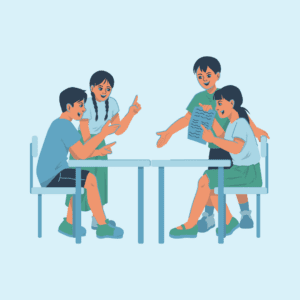National Child Abuse Prevention Month is upon us and there are many things that you can do as a confident counselor to foster child sexual abuse prevention in schools.
The idea of working with children who have been abused can be a scary thing for many educators. The reality of this, as a colleague often points out, is that if you work with children, you’re working with children who have been abused.
Although statistics are hard to nail down due to lack of reporting, an estimated 1 in 10 children experiences sexual abuse (direct contact) prior to the age of 18. We also know there are many unfavorable links between child maltreatment and academic achievement.
When those numbers are applied to real classrooms and students with whom we work, it can become overwhelming and emotionally exhausting. However, with the sheer number of children affected by indirect or direct sexual abuse, it’s imperative that schools address this public health issue. As schools strive towards being trauma-informed, here are some concrete suggestions to consider implementing for child sexual abuse prevention.
Signs and Symptoms
Cynthia Monahan, in her book Children and Trauma: A Guide for Parents and Professionals, identifies signs and symptoms of child sexual abuse.
It’s important to keep in mind that some children may not present with any signs or symptoms at all.
Another critical point regarding signs and symptoms is that even though a child’s behavior may be atypical within a school setting, it may not be an atypical response to trauma.
Children may also demonstrate sexual behaviors, and it’s critical to understand what behaviors are and are not considered typical sexual development.
Direct Instruction to Students
Students need to be taught about abuse prevention. Topics on child sexual abuse prevention include personal body safety, safe adults, tricky people, consent, healthy boundaries, assertiveness skills, refusal skills, and secrets and surprises, to name a few. Some states have regulations or mandates on teaching about sexual abuse, with specific curricula, while others may not.
Personal Touching Rule
Students need to know that there are rules about touch and their bodies, as well as what to do if something were to happen to them. Children are often taught that no one should touch the private parts of their body, specifically the areas covered by bathing suits. If this occurs, say no, go, and tell is the instruction that children receive.
Students should also know that they should not look at or touch anyone else’s private parts either, or look at pictures of other people’s bodies.
Encourage children to reach out to a safe adult if someone touches them in any way that makes them feel weird, confused, or uncomfortable, even if it is not sexual contact.
There is often a grooming process in child sexual abuse situations, and even if touch isn’t overtly sexual, children need to be empowered to trust their instincts and speak up when they are uncomfortable. (The same can be said for adults.)
Consent and healthy boundaries
Conversations about consent will vary based on student age and developmental level, but this is something that can be done with even young children. It’s about explaining to children that they have the right to say no, and modeling that when “no” is said, that the other person stops.
In elementary schools, day-to-day peer conflict can provide the opportunity to demonstrate this idea. For example, Luke keeps poking Suzie on the rug. When Suzie reports this to the teacher, the teacher’s response can include something along the lines of:
“Luke, Suzie is telling you that she doesn’t like the way you’re touching her body. She gets to decide what she’s ok with. You need to stop. Suzie, thank you for telling me that you were uncomfortable.”
Another example might include students hugging each other. Sometimes it’s very clear when kids are comfortable with this, but model consent with statements like,
“Suzie, are you ok with Luke hugging you right now? If not, you can tell him to stop.”
The same can be said for adult-to-child interactions in asking children if and how they would like to receive touch or physical affection. For example, if Luke gave his teacher a gift, she might respond with a statement like
“Luke, thank you for thinking of me. Is it ok if I give you a hug, a high five, or something else…?”
Secrets and surprises
Distinguishing between secrets and surprises is another lesson for students to learn. Secrets are things we are asked to keep private, but they make us feel weird and yucky inside. On the other hand, surprises are things that we keep private, but they are fun and exciting.
This is a powerful lesson and can be reinforced throughout the school year by all school staff. Working on a special Mother’s Day project? Emphasize to students that this is something to keep private since it’s a fun surprise. A peer tells them about bullying behavior they are experiencing on the bus? Point out to kids that’s a secret they must tell to keep someone safe.
Safe adults and tricky people
Direct instruction with children should include thinking about safe adults in their lives. 90% of child sexual abuse victims know their perpetrator.
Encourage children to think of school staff, extended family members, and/or other community members who may be safe adults. Ask them who they could talk to if they don’t feel comfortable sharing with a parent or guardian. Who do they trust? Who feels safe to them? Who could help them if someone was being hurt?
On a related note, tricky people might be someone that kids know a lot, a little, or not at all. They might say or do things that make kids feel weird or uncomfortable, or ask children to do things to “help” them when inappropriate to do so (think lost puppy at the park).
Children can be taught to evaluate what someone is saying, doing, and asking, and how that makes them feel. Anyone who asks a child to break safety rules or do something unsafe can be considered a tricky person, regardless of how well the child knows him/her.
Encourage conversation about safety
For many reasons, children may fear that they will get in trouble for disclosing. Sometimes perpetrators implicitly or explicitly threaten children.
It’s important that children understand that they can talk to safe adults without the fear of the adult being mad at them. Let your students know that your counseling space is a place where they can share anything they want. Encourage your colleagues and classroom teachers to explicitly tell children that they will never be mad if they have a safety issue they would like to share with them.
Provide them with additional opportunities to share information with you without having to verbally share, perhaps by a “note to the counselor” or “something I want you to know” jar.
Learning about feelings
As always, counselors and educators can help children express and manage their feelings. There are a variety of curricula and counseling techniques available to promote feelings identification, expression, and management for children of all ages.
The idea of sharing about feelings may be new to many students, and schools offer many opportunities to enhance children’s social and emotional wellbeing. By helping children learn the language of emotions and the skills to manage them, you are giving them an empowering gift and lifelong skill.
Educate parents and families
Educate parents and staff about child sexual abuse prevention and the ways they can help to keep kids safe. Share your knowledge with other stakeholders to bridge the gap between school instruction and home. It may be as simple as sending home a sheet that reviews the sexual abuse prevention topics covered in class, as explained above, or perhaps present to parents during an evening workshop.
Families can be encouraged to teach their children the anatomically correct names for body parts, and reinforce topics taught in school. They may need help on how to talk with their kids. It’s beneficial for children to have ongoing conversations with family members about safety in a calm manner. Children will benefit from consistent messages, and understanding that there are adults available to support them.
Engage with community providers
Reach out to community agencies about their outreach and education programs for child sexual abuse prevention. Many child advocacy centers offer prevention education programs for children or adults. Take them up on this, especially if colleagues are uncomfortable speaking with children and families about child sexual abuse or other abuse-related topics.
There may be programming options for students, presentations for parents and families, or professional development for staff. This can be a great opportunity to raise community awareness while empowering students, families, and school staff with facts. Not to mention, these programs are often cost-effective, if not free!
Additionally, be familiar with your community resources and referral options. Make the connections for students and families to work with individuals who are experts in the field of child sexual abuse for ongoing counseling and family support. Developing relationships with these service providers will go a long way to getting families connected with services.
Children need advocates, and it’s our role as counselors to help ensure that their voices are heard and their needs are being met.
Professional development
Counselors are always learning, and there are many terrific professional development opportunities on child sexual abuse prevention. Check out free resources available to you, and although school counselors do not provide therapy services, you may find this course on trauma-focused cognitive behavioral therapy helpful.
Disclosures
Despite our best efforts at prevention, there will come a time when you hear a disclosure of sexual abuse. When this happens, it’s imperative to understand your policies, procedures, and state laws. Make the report that you need to per your state laws to the appropriate authorities.
Unfortunately, sometimes counselors need to educate those within the school system who may not be following best practices. Years ago, a trainer suggested that the first interview should be the last interview. Well-meaning adults often inadvertently interfere with interviews and/or investigations.
Although difficult to sit with a child’s disclosure, try to maintain the perspective that a student trusted you with this information, and that you can be a light in their dark experience. As always, obtain appropriate supervision to process your own response.
Prevention Efforts Year Round
Although April is National Child Abuse Prevention Month, child sexual abuse prevention conversations and strategies are most effective when implemented and encouraged year round. Counselors play a powerful role in prevention and education, and no responsibility is as great as the safety of our students.








